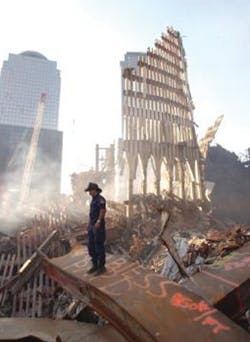FDNY Health Program Finds Evidence of Illness
The James Zadroga 9/11 Health and Compensation Act allows for evidence to be presented in order to get additional illnesses covered, Prezant explained. However, “It’s a process,” he said, and will take time.
A committee will have to study the evidence for each additional illness to be considered, and the committee hasn’t yet been formed. Prezant said it’s set to be formed in the fall, and he hopes to then see additional conditions added later this year or in 2012. The illnesses that currently qualify include asthma, interstitial lung disease and mental illnesses such as post-traumatic stress disorder.
“Our task is talking about the survivors,” Prezant said during his session, 9/11 Health Issues for First Responders, which he based on conclusions from his study of the physical and mental consequences of 9/11 with Dr. Kerry Kelly.
Prezant and Kelly are both chief medical officers with FDNY. Prezant responded to the World Trade Center on 9/11 and is currently co-director of the FDNY WTC medical programs.
The Dust
The dust released in the WTC collapses is blamed for health problems for several reasons, Prezant explained, particularly the particle sizes, extent of exposure, and pH.
“Large particles reached the lower airways” of responders, Prezant said. He acknowledged there has been debate about whether this is possible, but said the previous studies used in the argument don’t make a valid comparison. “This is not just a sinus problem,” he said.
Once inhaled, the alkaline pH of the dust has an inflammatory and scarring effect inside the body, Prezant said.
The Exposure
The massive dust cloud didn’t roll through the scene and dissipate. Hours after the collapses, photos show the area still enveloped. The air was thick for three to four days, Prezant said, and even after it then rained, aerosolized particles remained in the air.
Furthermore, those responders who were digging and searching in enclosed spaces continued to experience high-level exposure, rather then the dissipated level.
“We’ll never know all the different gases and chemicals we were exposed to; it wasn’t monitored during the incident,” he said.
By the end of the rescue and recovery operation, about 15,700 fire and EMS personnel were exposed to the WTC dust and gases, Prezant said. “Only a few hundred were never there at all, so this is a large population,” he said - not to mention the other responders and civilians.
Those exposed on Day 1 – about 1,900 fire and EMS personnel – had the worst exposure, with the level decreasing with time to arrival on site.
Evidence of Illness
Prezant began with microscope photos showing asbestos fibers, glass and fly ash particles located inside responders’ airways.
Most firefighters were coughing long after responding to 9/11, which is not normal, he said. “So we set up a program that started treatment and then monitoring starting four weeks after 9/11.”
The program is not mandatory but has had strong buy-in, he said. It completed 10,000 medicals by march 2002, and is now up to 15,750 which is 97 percent compliance, Prezant said. The program has treated nearly 10,000 personnel for mental or physical issues or both.
Initially 70 percent showed a cough and sore throat after 9/11. Then 7-9 years later about 12 percent continued to have a persistent, severe cough. Other symptoms increased, including wheezing and shortness or breath.
“The people who arrived first still have the worst symptoms,” Prezant said.
Prezant also took an in-depth look at responders’ drop in pulmonary function, using breathing tests that began in 1997 for baseline data. From ‘97 to 2001, the drop among personnel was normal compared to the regular population. In the first six months after 9/11, the drop was 10-20 times normal, he said.
“It is very, very convincing that 9/11 caused the drop,” Prezant said. Also, it appears to be a persistent drop, not a recovering drop. “This is persistent, real, and important,” he said. “There are always the naysayers who blame cigarette smoke,” he added, but says the program has data showing the effect on both firefighters who smoke and who don’t. “This shows this isn’t due to their fault,” he said.
Conclusions
“A substantial proportion of World Trade Center rescue workers have persistently abnormal lung function,” Prezant said. Large decreases in lung function are seen in the first year, greater for firefighters than EMS, with little or no recovery.
The conditions need to be monitored and treated, he said. For almost everyone the physiology is obstructive as opposed to restrictive, and while it is not curable, it is treatable and controllable, Prezant said.
The program also has thousands with asthma they can treat; 10 with pulmonary fibrosis; and about 30 with sarcoidosis.
For anyone outside FDNY who believes they were affected, Prezant advised seeing the NIOSH website’s World Trade Center Health Program at http://www.cdc.gov/niosh/topics/wtc/.
About the Author

Heather Caspi
Managing Editor, News Team
Heather Caspi is an associate editor at EMSWorld.com and has been with Cygnus Business Media since 2000, serving various roles with all three public safety sites. She graduated from the University of Maryland with degrees in Journalism and English Language and Literature, and earned her EMT-B through Merritt College and the Oakland Fire Department in Oakland, California.
